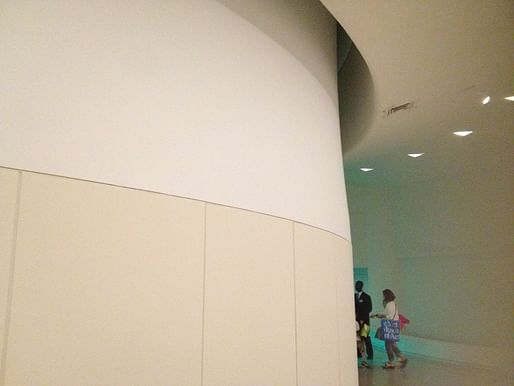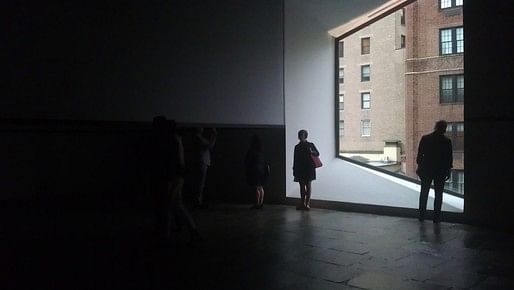
This summer in New York we are having a rare dose of major works from the West coast's "Light and Space" movement. That phrase Light and Space always makes me think first of Light and Air, that penultimate duo of Depression-era tenement reform and the 1916 New York City zoning.
The major Light and Space exhibition this summer is, of course, James Turrell at Guggenheim. The main focus of the exhibit is Turrell's Aten Reign installation, which takes over the Guggenheim rotunda. The work both repeats and obscures the ramps and the rotunda's skylight, in a way that could only make me compare the two, like a renovation that one unpeels in the imagination. To get myself out of this misplaced design-mind, I walked slowly up the ramp, but this only made it worse, as one can peer through the mesh and start to make out the scaffolding.
Conceptually, though, I was surprised the work had such a clear back and front. The piece seems to rely on a specific orchestration of movement that is at odds with the museum's circulation. Below is a photo taken from the ticket counter, for example - unavoidable, except at exclusive opening parties. Where is the immersion? The psychological dimension that we expect in Turrell's work doesn't do much here.

For all the theatrics at work in Turrell's Aten Reign, the Robert Irwin at the Whitney is way more mind-bending. I am biased, perhaps, because I spent sometime researching Irwin's work at the beginning of the summer for a talk I gave at Dia Beacon.


Irwin's piece at the Whitney is titled matter-of-factly Scrim veil—Black rectangle—Natural light, Whitney Museum of American Art, New York (1977). The work could be read as many things - from minimalist to hallucinatory. Somehow the fuzzy translucency of the scrim almost exactly replicates the blurring that one's eye creates when seeing something obliquely in dim light. The work is a kind of complicated homage to both Marcel Breur's quality of space - the precast ceiling, the column-free span, those masterful windows - and the act of seeing, itself. It is probably the best thing I have ever seen at the Whitney.
My own theory about the trajectory of Irwin's work is that he has been able to read architecture so well because he started with space travel. From 1968 through 1970 LACMA initiated a collaboration between Irwin, Turrell, and a human factor scientist, Dr. Ed Wortz working on manned space travel for NASA. Their collaboration culminated with the "National Symposium on Habitability" May 1970 at Irwin's studio (which also included Frank Gehry making cardboard furniture).
As Dr. Wortz told Irwin's biographer, "Bob really understands a line. I don't understand a line, but I am firmly convinced that he does. He understands it deep in his nervous system. He understands it from his cortex right down to his spinal column."
Posts are sporadic. Topics span architecture, urban design, planning, and tangents from these. I sometimes include excerpts of academic articles.
No Comments
Block this user
Are you sure you want to block this user and hide all related comments throughout the site?
Archinect
This is your first comment on Archinect. Your comment will be visible once approved.